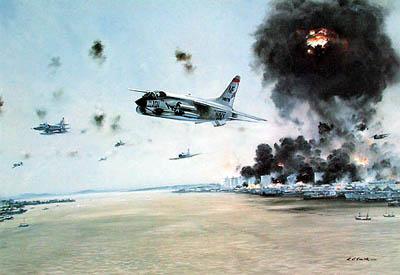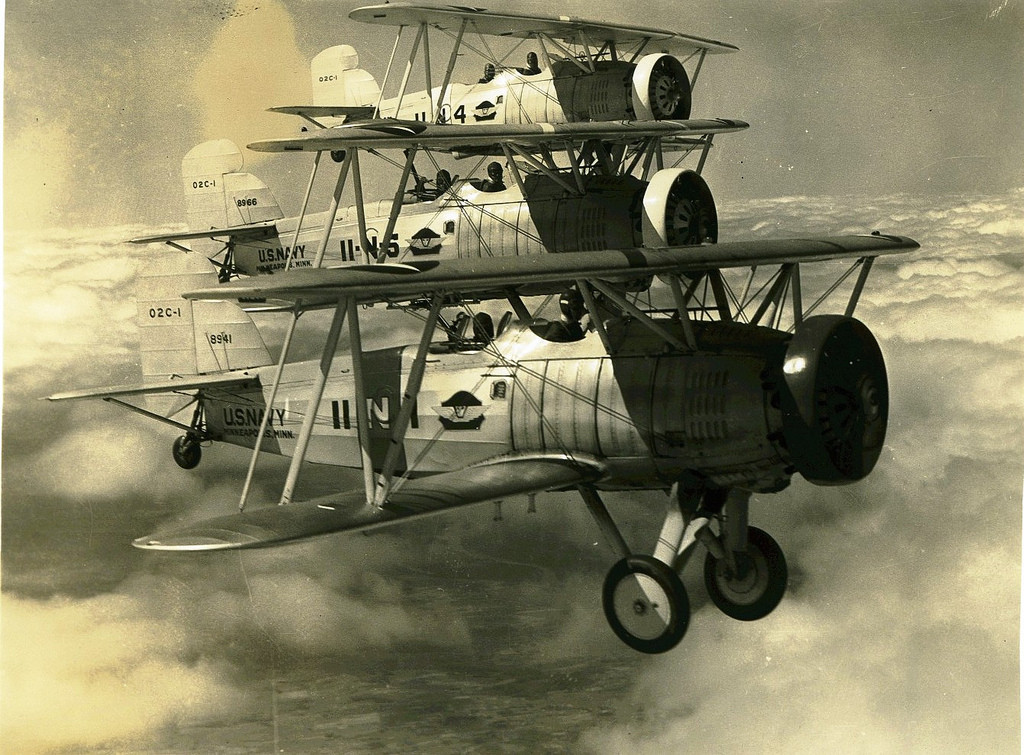Testimony of Pilot# 19
“… They leave this tiny ship and fly against the enemy. Then they must seek the ship, lost somewhere on the sea. And when they find it, they have to land upon its pitching deck. Where did we get such men?”
As the closing post in testimony’s Chapter 3 – Where did we get such men? – the purpose is first, to add to the collection a fairly well traveled but I think spot on piece The Fighter Pilot, by an unknown – obviously Air Force – author;
and second, to provide some discussion of the characterization of what such men and women really do – despite the fighter pilot label – and will continue to do in the future. Truth be told, it’s really what they’ve always done though sometimes Red Baron semantics and emerging technology tends to blur the picture.
Cdr James Stockdale leading the Operation Pierce Arrow strike on Vinh, North Vietnam as the result of the Gulf of Tonkin incident in August 1964 by R.G. Smith.
The Fighter Pilot
author unknown
Say what you will about him: arrogant, cocky, boisterous, and a fun loving fool to boot. He has earned his place in the sun. Across the span of 95 years he has given his country some of its proudest moments and most cherished military traditions. But fame is short-lived and little the world remembers.
Almost forgotten are the 1400 fighter pilots who stood alone against the might of Hitler’s Germany during the dark summer of 1940 and gave, in the words of Winston Churchill, England “It’s finest hour.” Gone from the hardstands at Duxford are the 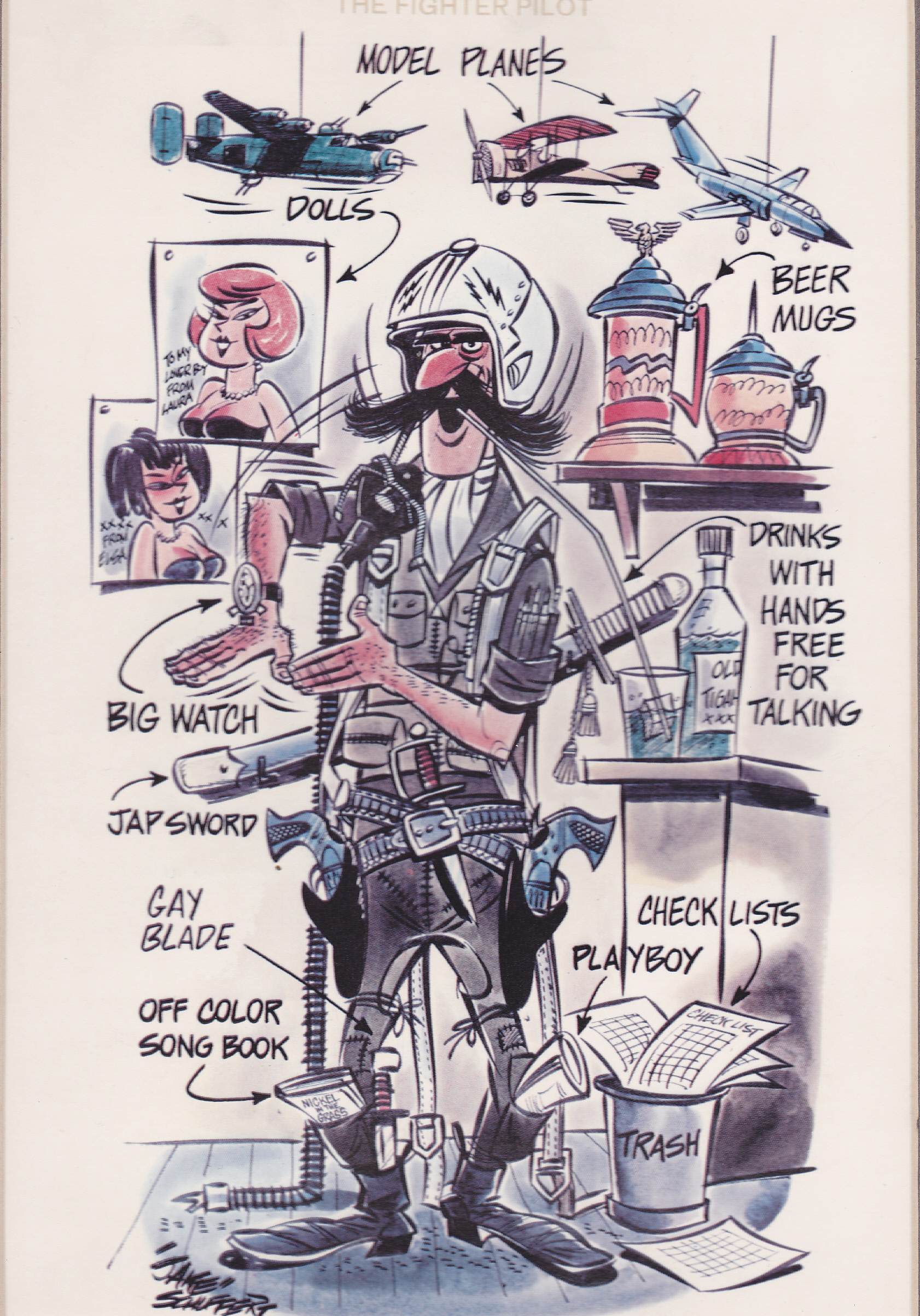 51’s with their checkerboard noses that terrorized the finest fighters the Luftwaffe had.
51’s with their checkerboard noses that terrorized the finest fighters the Luftwaffe had.
Dimly remembered, the Fourth Fighter Group that gave Americans some of their few proud moments in the skies over Korea.
How fresh in recall are the Air Commandos who valiantly struck the VC with their aging “Skyraiders” in the rain and blood soaked valley called A-Shau? And how long will be remembered the “Phantoms” and “Thuds” over “Route Pack Six” and the flack-filled skies over Hanoi?
Barrel Roll, Steel Tiger, Tally Ho. So here’s a “Nickel on the Grass” to you, my friend and your spirit, enthusiasm, sacrifice, and courage–but most of all, to your friendship.
Yours is a dying breed and when you are gone, the world will be a lesser place!
The testimony of pilot series is focused on capturing and providing in one spot the stories of aviation that as a group characterize in most part the clan of fast mover combat aviators. Some are true representations of events , some may include some shall we say imaginative stretches, and some while fiction are based on observed reality like Michener’s The Bridges at Toko-Ri. Readers may have read the stories or recognize the events and writers of a great many of the stories, but some stories may not have emerged beyond the covers of the many aviation specialized books or beyond a particular group within the overall clan.
The general public and indeed many writers tends to use the term fighter pilot in a generic catch-all sense so a question remains: when we say “fighter pilot,” who exactly are we talking about and what do they really do? Well, you say military pilots, guys in fighter squadrons, like the F-14 guys in TOPGUN or 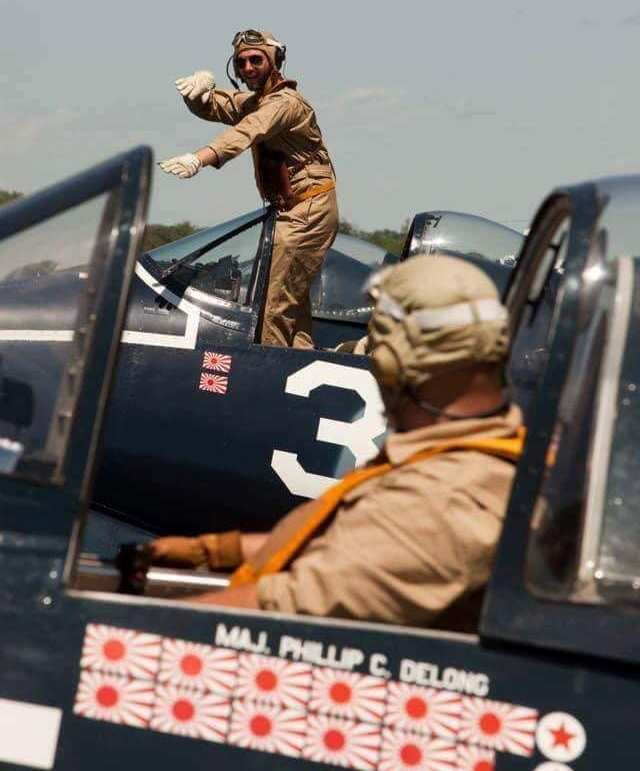 The Blue Max, or aces like the Red Baron, or Rickenbacker, or Robin Olds – fighter pilots of course. You know “These guys who talk with their hands and shoot down their wrist watches” —>
The Blue Max, or aces like the Red Baron, or Rickenbacker, or Robin Olds – fighter pilots of course. You know “These guys who talk with their hands and shoot down their wrist watches” —>
But now take a quick look at the quote above beginning right under the cartoon characterization – Skyraiders, Thuds, and Route Pack Six is referring not just to what supposed true fighter pilots do – air-air – but also to the missions of the air-ground attack guys. The author has grouped lots of missions under the umbrella of fighter pilot. While the term fighter pilot spun from the change from Army Air Corps pursuit pilot terminology of WWI and WWII (and a/c designation, I.e., P-51 and as of 1948 F-51), this multi-faceted context of fighter pilots has existed forever for the Air Force in Tactical Air Command with the designation of all tactical fast movers to Tactical Fighter Squadrons (TFS) as compared to bomber pilots who flew big, multi-engine multi-crew aircraft like B-17’s, B-29’s, B-52’s, etc.
In US Navy carrier air-wings on the other hand, squadrons, aircraft and pilots were designated by mission – air-to-air or air-to-surface/ground. This practice stems from the very earliest days of carrier aviation with the first squadrons on the Langley and Saratoga with VF, VB (for dive bombers) and VT (for torpedo bomber) and continued throughout WW II. After the Korean War the terminology morphed to VF and VA, (“A” for attack) and indeed aircraft design and training was driven by that context. [F-8 Crusader, F-4 Phantom vs, A-1 Skyraider, A-4 Skyhawk, A-6 Intruder, and A-7 Corsair. But of note, A-7D’s for the Air Force were in Tactical Fighter Squadrons and the A-10’s of today are in a TFS].
Alas, technology has long surpassed that employed by the Red Baron or Ens Hopkins at Midway, or David McCampbell at the Marianas Turkey Shoot, or Don Conroy at Chosin, or Randy Cunningham or Steve Ritchie in Vietnam. Today’s aircraft design reflects stealth capability, very high end sensor systems and the evolution of multi-role strike-fighters.
These new do-it-all aircraft have received great scrutiny and criticism particularly on their performance in the “phone booth,” I.e., the dogfight. But it should be noted that the design context of multi-role tactical aircraft is hardly new having been a part of services requirements for tactical aviation since its earliest days. For example, desires for multi-role aircraft is most evident in the late 1920’s Curtis F8C-1/2 Falcon which was intended as a two seat fighter (with rear gunner) that could maneuver with single seat fighters, plus dive bomb and conduct scouting or observation missions.
Variants of the original Falcon were used by the Army Air Corps, Marines, and Navy and was the first fighter-bomber, if you will, named Helldiver. It can be seen in multiple films including the attack on King Kong.
Jump forward to when the Navy bought the F-4 Phantom for fleet defense and fighter escort, it still routinely was armed with bombs for major Alpha Strikes into North Vietnam. The Air Force went even further intending their version of the Phantom as multi-role right from the start. But interestingly enough an early evaluation of Air Force air-ground warfare in the early days of Rolling Thunder – the Graham Report – recognized that aircrew were over tasked and lacked proper training for the multitude of missions they were routinely tasked to perform. From a PHD thesis on evolution of the Red Flag training concept after Vietnam:
Throughout the Vietnam War, Air Force officers developed new ways of employing the aircraft they flew. Many pilots, tasked to accomplish many types of missions, could not become proficient in any of them. Aircraft designed for a singular purpose (air-to-air intercepts, nuclear delivery, or deep interdiction) and their crews performed air-to-air missions one day, only to be sent against ground targets the next. One squadron might perform an Iron Hand mission to protect a strike package and the next day be the strike package. Fighter pilots in many units became jacks of many trades and masters of none. Tactical Air Command recognized the need for pilots to specialize in one mission set…
One answer was creation of “designed operational capability” statements, called DOC statements for short, which allowed a fighter squadron to focus on one primary mission. DOC statements detailed the primary and secondary mission a fighter squadron was capable of accomplishing and thus allowed more senior planners to easily task squadrons for particular missions. By 1972 you could tell the primary mission of an Air Force F-4 squadron by its home base in Thailand. For example the air-air mission was focused out of Udorn and Ubon, home of the 8th Tactical Fighter Wing was lead for precision-guided bombing. In effect they had adopted the Navy’s VF-VA concept but utilizing the same F-4 Phantom aircraft.
While air-air was considered the major mission of interest and therefore the mark of the fighter pilot, triple ace General Robin Olds noted in a magazine article The Lessons of Clobber College
The MiG pilots are a lot better than the average German pilot toward the end of WWII….Sometimes, when they’ve forced us to jettison our bombs before reaching the target, we’ve had to go in and teach them a lesson or clear them out. But our basic job over there is to bomb targets, not chase MiGs. If they happen to get in the way, so much the worse for them.
It is noteworthy that Olds received an Air Force Cross not for his four MiG kills (added to 12 from WWII) but for leading the 11 August 1967 strike against the Paul Doumer Bridge, a major north-south transportation link on Hanoi’s Red River.
On the Navy side, Commander James Bond Stockdale as Commanding Officer of VF-51 led the August 1964 first strike against North Vietnam – operation Pierce Arrow – in his F-8 Crusader fighter armed with rockets and guns. (Opening picture) The strike took advantage of the A-1 Skyraiders ability to carry a heavy load and the attack pilot skill, bomb load and maneuverability of the A-4 Skyhawk, along with speed and maneuverability of the Crusader to create a coordinated attack on the Vinh petroleum storage.
Indeed, maybe the characterization is best described by Air Force F-105 and F-4 fighter pilot Ed Rasimus: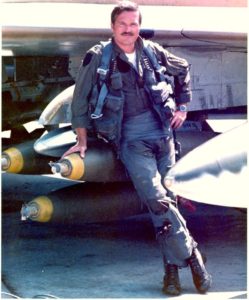
Air-air, its what you do going into and out from the target.
Naval air of today with its airwings of one and two seat F/A-18 Super Hornets merged VF and VA to multi-mission capable strike fighter VFA squadrons.
Current defense system threats are significant and the multi-role strike fighters design is most costly, but one must consider the long term cost of building and supporting combat a/c designed for specific missions. Defense technology pundits routinely suggest the demise of the “fighter” (or Attack aircraft) and note that the future of air combat lies in unmanned combat vehicles. So what’s a mother fighter pilot to do?
For purposes here, its worth stating that there is a terminology issue, a technical issue, and cost issues that run parallel to the mission capabilities of the fast movers. And a significant amount of criticism on the multi-role fighters to my mind has been leveled based on an outmoded definition of what a fighter aircraft must do in today’s threat environment to succeed AND survive. No matter what you call them, no matter the terminology – fighter, fighter-bomber, multi-role fighter, strike fighter, or attack aircraft, while in application of airpower, all may have better or worse capabilities in one mission area over another, in the end they must be capable of playing out that role in supporting the overall warfighting mission. The handwriting is on the wall – future fighter pilots will fly and fight doing a variety of missions in a multi-role aircraft.
No matter where future combat aviators come from they will always have to meet the criteria as set forth by Robin Olds –
fighter pilot is an attitude. It is cockiness. It is aggressiveness. It is self-confidence. It is a streak of rebelliousness, and it is competitiveness. But there’s something else – there’s a spark. There’s a desire to be good. To do well; in the eyes of your peers, and in your own mind.
These men and women – some recognizable, even famous, some just doing their duty – all certainly matched that characterization
Where do we get such folk indeed?
and
when their like are gone, the world will be a lesser place!

